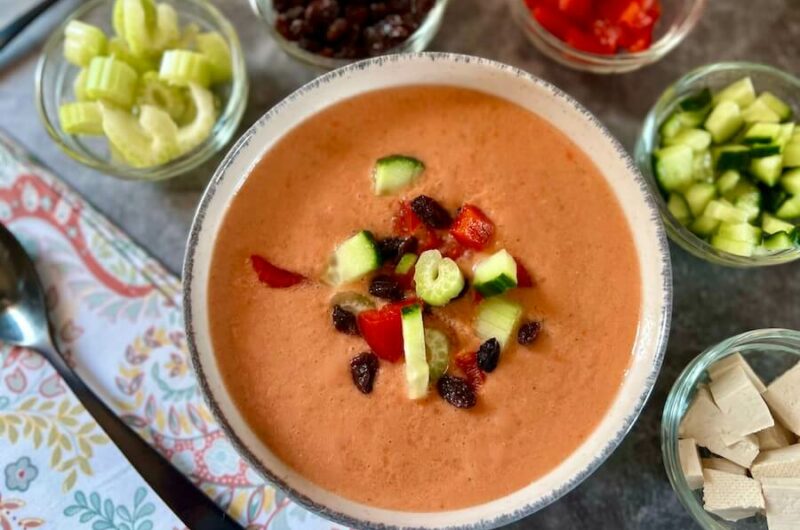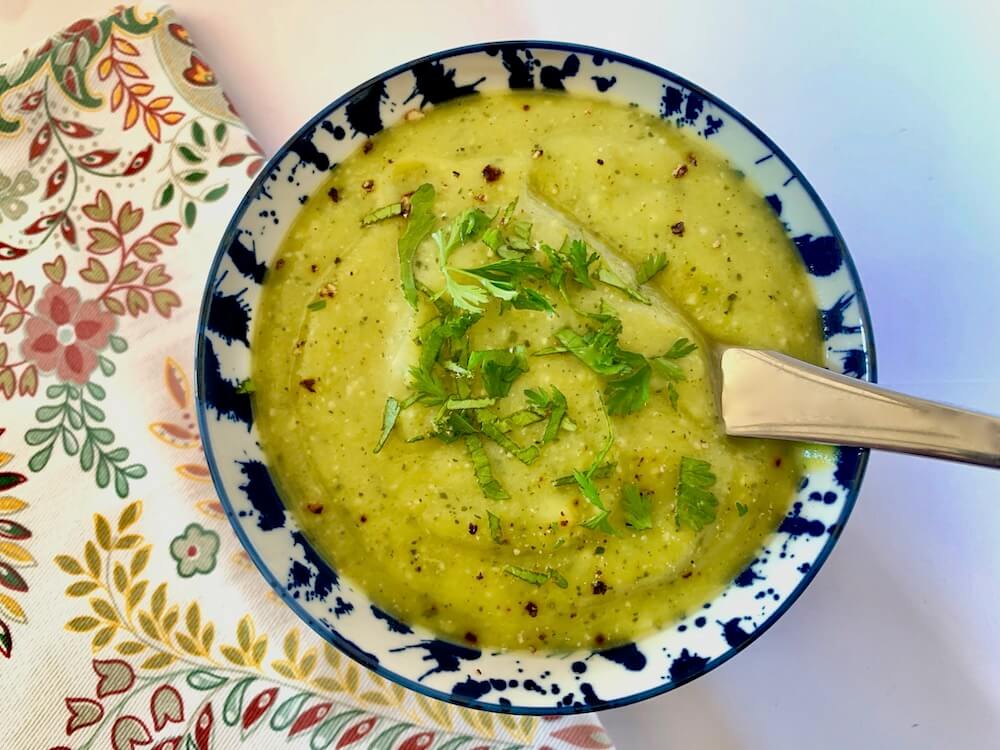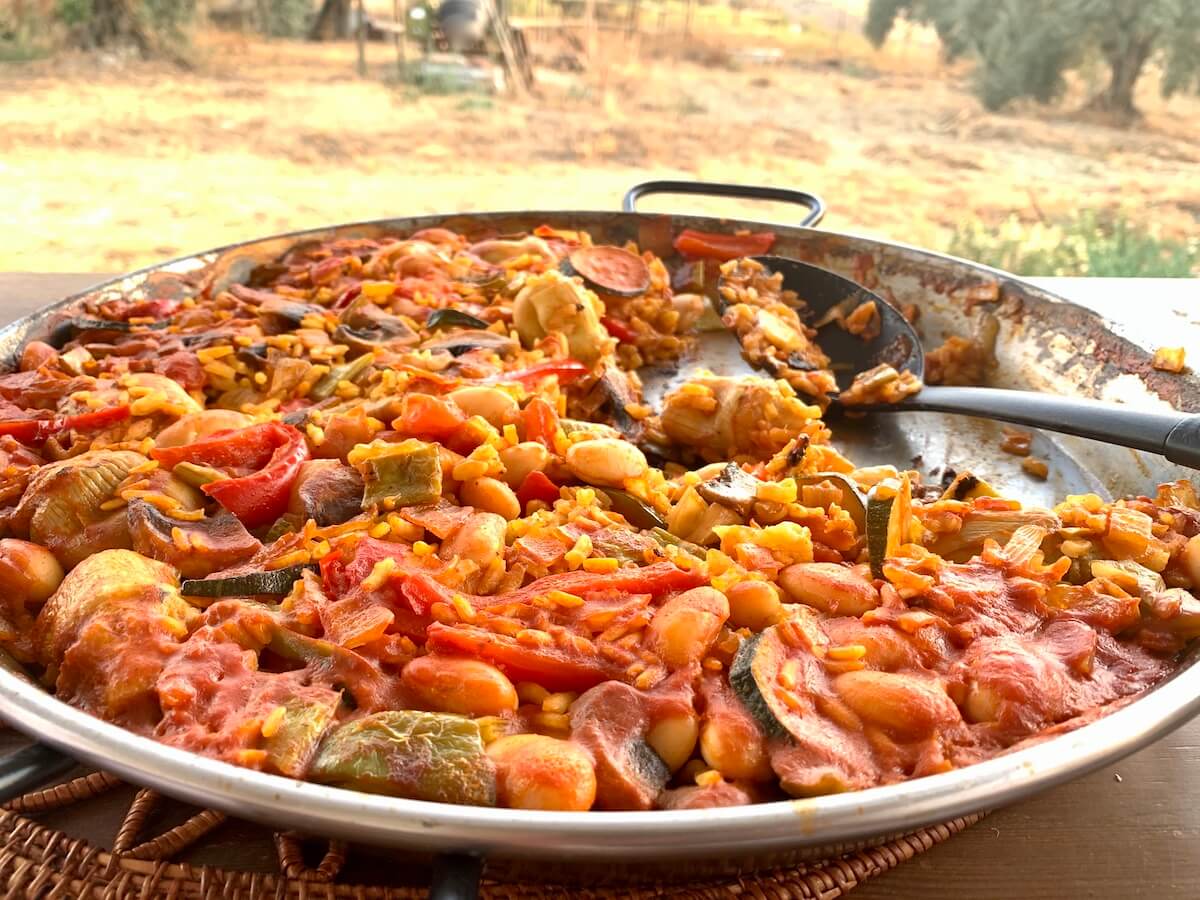Fancy a delicious bowl of chilled Spanish gazpacho?
Straight from summertime in Andalusia, this recipe can be made and ready to serve in under 10 minutes.
It’s a refreshing and nutritious bowl of goodness during the heat of summer.
Originally, gazpacho used to be served to the farm workers of Andalusia because it was cheap because they could use up surplus tomatoes and abundant olive oil which is produced in the area.
But gazpacho’s a well-known recipe in most of the world now, because of its simplicity, delicious taste and ability to keep you cool on a hot day.
Gazpacho’s right up there along the lines of paella when it comes to famous dishes from Spain.
And rightly so.
Because you know the best part, right?
No cooking is needed!
I mean who wants to turn on the oven or hob when it’s 35ºc outside?
Just a food processor and the easy-to-find ingredients, et voila!
Gazpacho’s traditionally served in a glass or bowl and the choice is yours (but I much prefer a bowl).
Serve as a soup for starters or a light lunch, or serve a glassful on the side of your lunch as a tasty refreshing drink.
And I guess everyone has their preference. For me, it’s a bowl every time because I love to load it with toppings and eat it with a spoon.
If you become a gazpacho fan like I am, you’ve got a feast awaiting you in these other gazpacho variations.
- Melon Gazpacho
- Watermelon Gazpacho
So without further ado, let’s get blending!

Table of Contents
Ingredients for an Authentic Spanish Gazpacho from Andalusia
Tomatoes for Gazpacho
The flavour of your gazpacho will vary depending on the type and the ripeness of the tomatoes you have. The redder and juicier the better.
It isn’t that you have to have a specific type, but here in Andalucia we have a lot of choices – tomatoes galore in fact – and they tend to be bigger, fatter, redder and juicier than the standard ping-pong-ball-sized tomato commonly eaten in the UK.
If you don’t have access to any big fat ripe tomatoes, you could choose plum tomatoes as they work well enough.
Go for the fattest and juiciest tomatoes you have available.
The exact quantity of tomatoes varies each time depending on the size of the tomatoes and how much gazpacho you want to make.
As an example, 1 kg of tomatoes would make a jug full of gazpacho, but it could also be made with as little as 750g.
You’ll find that with time you’ll soon be throwing all the ingredients into the blender without worrying about quantities. It becomes a matter of feeling.
Do you have to peel the tomatoes for gazpacho?
Peeling the tomatoes is a matter of personal choice. Firstly, if you have a super-duper expensive food processor it won’t be necessary because your machine with fully grind up the skins.
But if you have a standard household food processor then you will get a smoother result from peeling the tomatoes than if not.
Ultimately it’s up to you. I don’t peel the tomatoes but I do remove the tiny hard bit at the top of the tomato.
Fresh Garlic in Gazpacho
Garlic’s an essential part of a delicious gazpacho.
Without enough garlic, the gazpacho can lack a certain zin, but garlic can also overpower the flavour so it’s important to be careful with your quantities when it comes to this ingredient.
I find that too much garlic will make me suffer after eating the gazpacho, so I prefer to lean towards less rather than more. I usually use one small clove weighing 2g or half a large clove.
Green Pepper in Gazpacho
Traditionally we use 1 small green Spanish pepper in gazpacho (about 80-100g) but this is where things start to get personal from family to family.
Each household has its own method and preference when it comes to making gazpacho and how much green pepper to add.
And what if you don’t have any Spanish pepper to hand?
You can sub for bell pepper or even for red bell pepper.
Of course, in Andalucia, these variations aren’t classic and many people won’t consider red pepper as a substitute for green pepper, but I’ve made gazpacho with all types of pepper and it’s always delicious.
So play around with it until you find your preferred gazpacho soup!
Cucumber in Gazpacho
A chunk of cucumber in gazpacho is traditional – but not everybody adds it. I know families who leave out the cucumber.
I like to include it, but it isn’t crucial to be honest.
The traditional cucumber here in Spain is the smaller, shorter variety than the UK cucumber, but either will do the job.
I like to include the cucumber when I have one to hand because I love the final results, but if I don’t have a cucumber to spare, I’ll still make a delicious gazpacho.
I typically use about 100g of cucumber but you don’t need to be too fussy on quantities. That’s one of the things I love about making Gazpacho, just throw it all in and taste the results!
Of course, you can also make a delicious cucumber gazpacho and then you can’t omit the cucumber!
Onion in Gazpacho
Of all the ingredients, onion is the most often debated in the area where I live.
There are those who do and those who don’t.
If you choose to experiment with adding onion, just start with a small piece to begin with and use a sweet onion variety such as a spring onion or a red onion for example.
I prefer not to add onion to gazpacho as I find it delicious without it, but either way is good.
The authentic Andalucian gazpacho doesn’t always have onion in it.
Salt in Gazpacho
Gazpacho is salty.
No, you might not recognise that when you eat a delicious gazpacho, you may just think OMG how delicious is that!
But to get that awesome flavour it needs to have a lot of salt in it.
I use Himalayan salt and add about 50g to a jug of gazpacho.
But different salts have different strengths, so you’ll need to play around with it until you get the amount that works for you.
Olive Oil Vinegar and Water in Gazpacho
Gazpacho’s actually an emulsion between the olive oil and the water/vinegar and it’s that emulsion which gives it the creaminess.
So making an oil-free version of gazpacho doesn’t work.
You can do it, but the liquid separates and it doesn’t taste anything like gazpacho. It becomes a bunch of mushed-up tomatoes separating from the water.
Yes, you can do it. But does it taste as good? No way.
Believe me, I’ve tried gazpacho all ways!
I remember when I first saw gazpacho being made, how surprised I was at the amount of olive oil that went into it.
I had previously made it with a tiny dash of olive oil but my results weren’t so creamy.
And then I saw a friend making it and she tipped in the olive oil in what seemed to me to be copious amounts.
And then I learned that that was standard here in Andalucia.
Although I never weigh the oil, I just tip some in, it’s around the 60ml mark for a large jug of gazpacho and it’s the oil that gives the creamy result.
You can reduce the oil and play with it if you like, just remember that the consistency depends on it to a certain extent.
White Wine Vinegar, Apple Cider Vinegar or Sherry Vinegar
The vinegar’s crucial for making the flavour pop.
Don’t worry, you can’t actually taste the vinegar in the final soup, but you can definitely taste the lack of zest if you forget to add it.
As vinegar can be tweaked, start by adding a double dash, blending the soup, then taste and adjust.
Add a little more until you get the balance right.
My go-to choice is white wine vinegar but you can sub it for one of the other types of vinegar if that’s what you have in your kitchen.
Water in Gazpacho
Everybody likes their gazpacho chilled but one of the best things about this recipe is that you can eat it immediately.
Gazpacho’s always best eaten fresh and you can’t get fresher than straight from blender to bowl.
To achieve this we use ice cubes instead of water. Simply add 3 of the super-sized ice cubes to the food processor (or more if using small ice cubes) and blend.
This achieves the perfectly chilled soup you expect from a bowl of creamy gazpacho.
If you don’t have a food processor which can handle ice, then you’ll need to use water.
Chill the water in the fridge for several hours before making the gazpacho.
It’s crucial that the soup is served deliciously cold.
Toppings for Gazpacho
Traditionally the toppings are made from finely chopping up the actual ingredients of the gazpacho – so finely chopped pepper and cucumber and a drizzle of olive oil over the top.
This is where I like to get non-traditional.
My favourite way to eat and serve gazpacho is by loading it with toppings. I’ll add chopped peppers and cucumber sure, but I’ll also add some raisins (essential!) and some cubed tofu because I’m a tofu fan and love the fact that it adds protein to the dish.
I don’t normally drizzle olive oil over the top, though it can look nice for presentation purposes.
Tips for Making the Best Gazpacho
- Use the reddest, juiciest tomatoes available
- Don’t skimp on the olive oil
- Use a dash of white wine vinegar and add more at the end according to the taste
- Go easy on the garlic
- Use plenty of salt – it creates the flavour
- Choose green (or red) peppers
- Use ice in the blender for an instant chilled soup
- Add cucumber and onion according to your preference
Other Vegan Recipes You May Like from Spain
- How to make vegan paella
- Spanish roasted pepper salad
- Pisto recipe from Spain
- Spanish zucchini soup recipe – Crema de calabacín
- Spanish vegan lentil stew recipe
- Spanish omelette vegan style
Authentic Spanish Gazpacho Ready in 10 Minutes
Course: All Vegan Posts4
servings10
minutesDeliciously chilled tomato soup from Spain
Ingredients
1kg tomatoes
100g green pepper (1 small Spanish or Italian pepper)
100g cucumber (1 small Spanish cucumber)
50-60ml olive oil
a good dash of white wine vinegar
15 g Himalayan salt (or other)
3 large Ice cubes or 200 ml chilled water
Optional slice of red onion
Raisins and finely chopped pepper, cucumber and tofu for sprinkling on top.
Directions
- Add all the ingredients to the food processor and blend until smooth
- Pour into a jug and serve in a bowl or a glass
- Serve with raisins and finely chopped pepper, cucumber and tofu on top.
- If not using ice cubes, chill before serving.
Notes
- Create the delicious flavour of Andalusia, ready to serve in 10 minutes.








